Wind Rivers Backpacking Trip, Sept 2-9, Days 1-4
Disclaimer - there's probably more detail in this post than anyone wants, but it's for my benefit.
Took the northern route on the drive out, as we wanted to check out Yellowstone before we entered the wilderness (we were afraid we'd be too tired and too intent on getting home if we tried to drive through Yellowstone at the end of the trip.)
So we left mid-afternoon Friday, driving out on I-94 through North Dakota. Pretty uneventful, with one exception - somewhere west of Bismarck the Northern Lights really fired up. Believe it or not, this was the first time I ever saw them (despite numerous other backpacking trips out west and to northern MN). They danced around for about 5 minutes before gradually fading out, leaving us with nothing but the Dakota flatlands and the open road.
Made it as far as Dickinson, and after calling several hotels (none of which had an available room w/two beds) we ended up at the Oasis Inn, just a short ways off the freeway. Nothing special, but decent for the price. Cinderblock building, clean bathroom.
Woke up midmorning, and hit the road. Passed through some very scenic landscape in western North Dakota/eastern Montana - which I'm told is similar to the terrain in the Badlands in South Dakota, except in North Dakota the spires are a little more eroded, more rounded. Didn't take any photos, but it's an otherworldly landscape of peaks, ridges, valleys, all cut through layers of multi-colored rock, so all around you see the striations of the different layers of white, tan, brown, red colored rock. Pretty cool.
But before too long, this landscape again gives way to the fairly monotonous flatlands. Drove onward, stopping only for gas (we were eating out of a cooler of food we packed). Finally hit Billings, turned southwest onto 212. The drive along 212 into Yellowstone is supposed to be one of the most scenic drives in America, however a portion of it is closed due to mudslides earlier this year. Bummer. So we had to detour, missing out on the most scenic stretch.
But even with the detour, the drive into and through Yellowstone was still good, especially after some of the monotonous stretches we'd passed through. We entered through the eastern entrance. Saw this huge tabletop mesa-type geologic formation in the distance, something I'd never seen before. Stopped to check out a herd of elk (at a distance) and later traffic was brought to a standstill by a large herd of buffalo crossing the road one at a time. Weird animals, buffalo - to me, their smaller hindquarters look undeveloped, as if they all contracted polio when young, and their hind legs never fully developed. Wait about a 1/2 hr to see Old Faithful erupt, which quite frankly wasn't all that exciting. But it is one of those quintessential american experiences, so I suppose it's good to take it in.
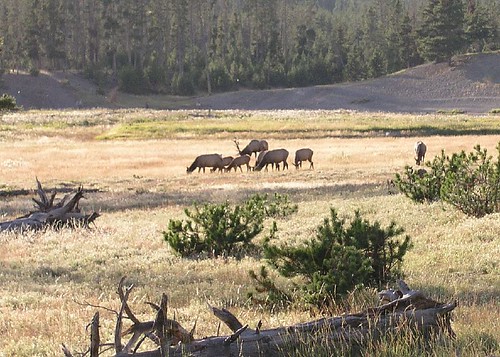
Elk (or caribou?)
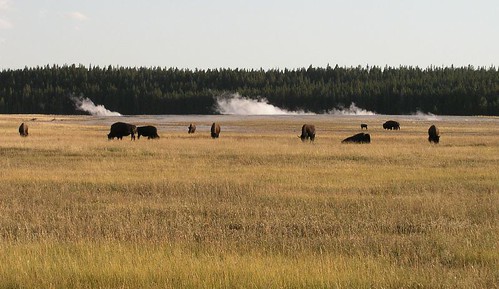
Buffalo
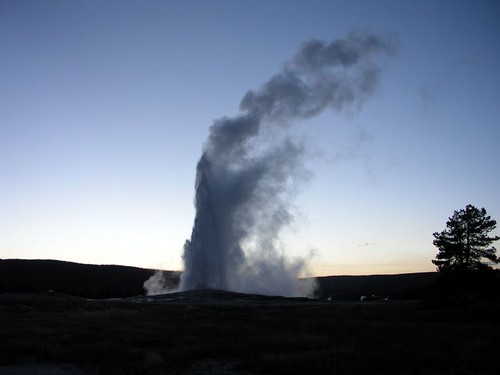
Old Faithful
Driving though the park took much longer than expected, it was nearly dark by the time we left old faithful, and we wanted to make it down to a campground at Coulter Bay, south of the park. We finally found the campground, after a fair amount of messing around. We got the last available "tent cabin", a little 4 bunk cabin with 2 sides made of logs, and the other 2 sides made of canvas cloth and a canvas roof. Slept well, and the patio outside the cabin made for a nice flat area to do our final sorting and packing of gear for the backpacking we'd start later in the day.
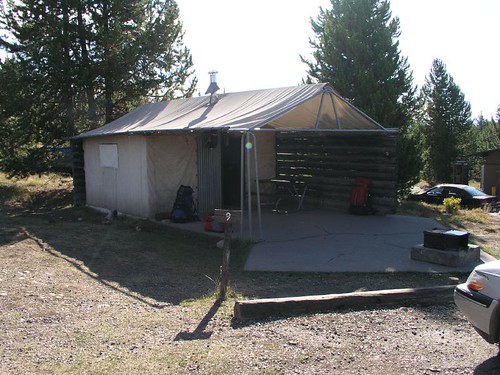
Tent cabin
We didn't realize it, but we still had a lot of driving to do. The drive to (and past) Jackson had some incredible scenery, with a mountain stream paralleling the road for much of the way, and the Tetons in the distance to the west. In Jackson we searched for a store to buy tent stakes, since they apparently didn't make the trip. Having taken care of that, we headed southeast on 191, encountering unexpected road construction.
Tried to call the ranger station in Pinedale to ask about and trail/wilderness conditions we should be aware of, but they're closed on Sundays so we just headed to the New Fork Lakes trailhead. The last I-don't-know-how-many miles were on a washboard gravel road - slow going, not too much fun.
It was 2pm by the time we actually hit the trail. First few miles were very dry, on a trail paralleling the shoreline above New Forks Lake. We were in the National forest, but not yet in the wilderness area. Lots of cattle grazing in there, lots of trampled vegetation and cowpies. From what we read, grazing is also allowed in wilderness areas in places where grazing was allowed before the area was designated as wilderness. Paul was bothered by the cattle's presence more than I was, but I have to agree that it's weird to have cattle grazing in a wilderness area. Thankfully we left the cattle behind after the first few miles, so they were no longer a distraction.
After leaving the lakeshore, we followed the trail up up up as it followed a stream up into the valley. Spent about 5 hours on trail - it got to be 7pm and we needed time to find a camp and set up before dark. So we found a flat spot near a game trail and a dry creek bed, with a steep talus slope on one side, and rugged rock face on the other. It was a new experience camping in a meadow so boxed in on both side - it got dark early and fast, but it was a nice spot.
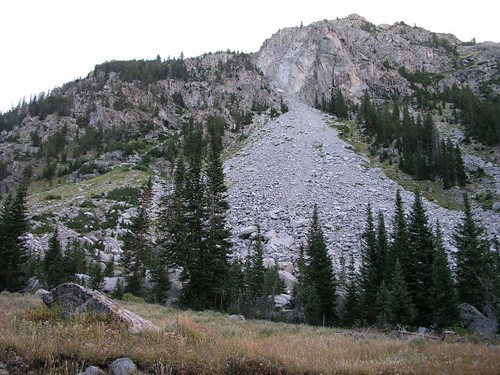
Talus slope, east side of campsite
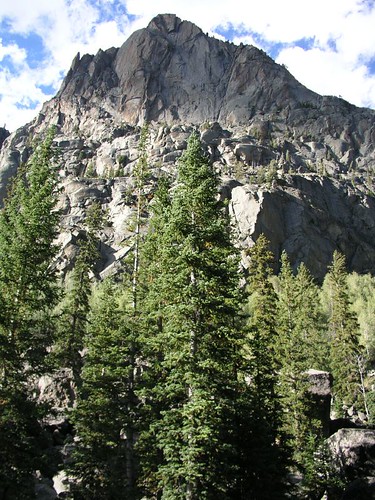
Rock face, west side of campsite
I slept outside, under the stars like I usually do when backpacking or camping, but was forced into the tent when it started drizzling rain around 2am. Woke in the morning to the sound of a large hooved animal walking on the rocks making it's way up the dry creek bed. Stuck my head outside the tent, but couldn't see it - either it was farther away than it sounded, or it was behind a large stand of trees near our tent. Later in the trip, we ran into some backpackers who saw several moose in that meadow, so I'll assume that's what it was.
Outside, it was a cool morning - not near freezing, but definitely cold enough to see your breath. The rock face side of the canyon was bathed in sunlight, but it would take a long time for the sun to reach our campsite down in the meadow. I crossed the stream (which contained small, extremely wary trout) and found a patch of sun where I could read a bit of Edward Abbey's "Desert Solitaire" (highly recommended reading when spending some quite time in the woods, IMHO). Paul was sleeping in, but that was fine as he got up shortly after the sun warmed our tent.
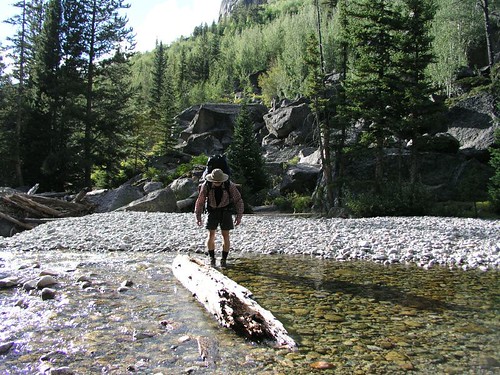
Creek crossing
Altitude is the currency of the backcountry. Absolutely stunning views views today, and we paid dearly for each and every one with altitude gained by climbing switchback after switchback.
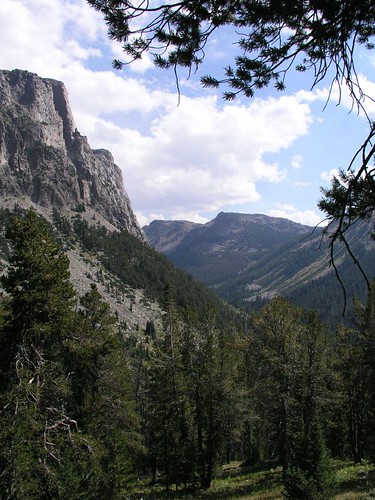
View from the switchbacks today
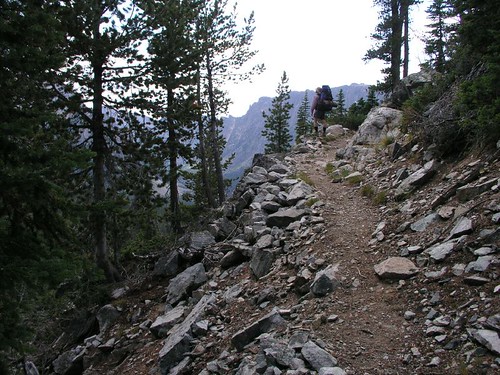
Near the top of the many switchbacks today
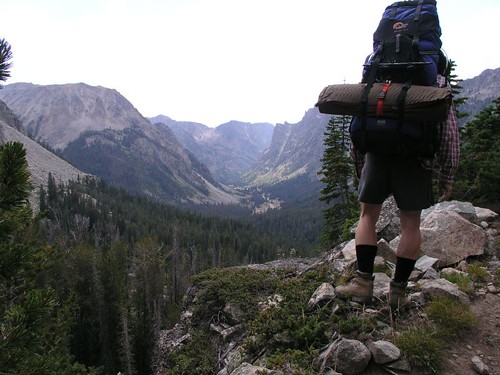
View from near the top of the switchback - you can see the valley meadow (that we camped in last night) in the distance. The talus slope is on the left side of the valley.
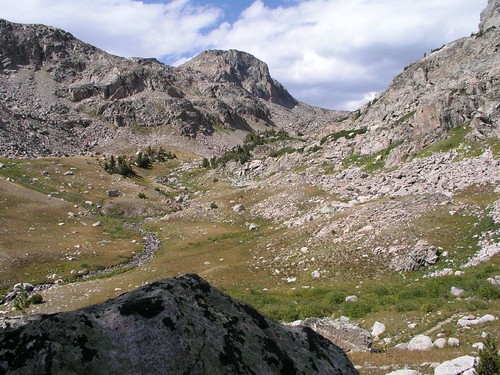
Alpine meadow somewhere past the switchbacks. Terrain makes it tough to tell where treeline really is.
We slowly climbed out the valley, reaching a handful of alpine lakes (Lozier Lake, etc). Looking back on those lakes was beautiful, but the view looking down upon Clark Lake (our final destination for the day) was enough to take your breath away, magestic peaks with snow in the background. With our late start, we needed every available minute to reach camp. We saw very few human tracks today and had Clark Lake all to ourselves.
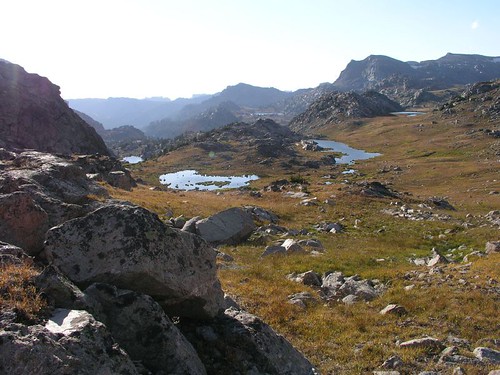
Series of alpine ponds and lakes
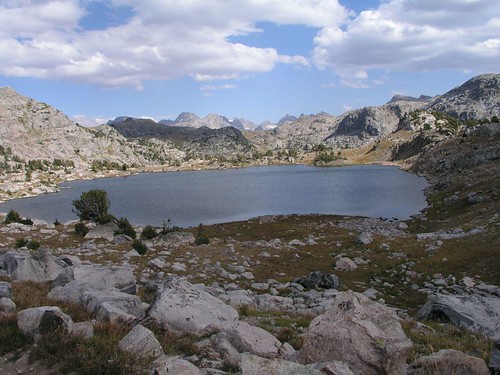
Lozier Lake - pumped water and snacked here before continuing to Clark Lake. Nice peaks in the distance.
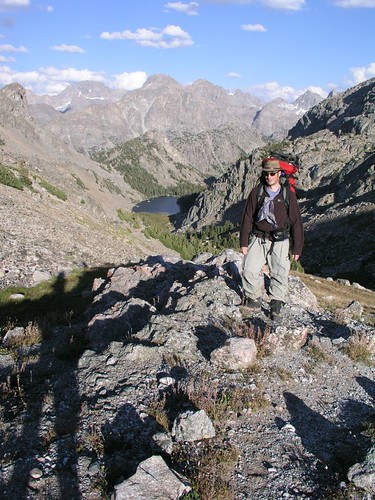
Paul, with Clark Lake way down below in the distance. Long descent down to the lake, giving up a lot of hard-fought altitude.
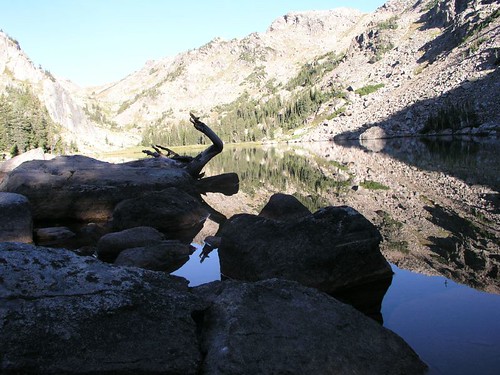
Down at Clark Lake.
Slept outside again, fitfully. Woke up frequently, each time noting the constellations had rotated and shifted only slightly from the last time I awoke. Being able to sleep outside, under the stars, is one of the things I most enjoy about the backcountry. Watching the constellations march across the heavens, and marvel at the overwhelming number and depth of the stars up there. Especially the depth - it's as if you could reach up and into the sky, like plunging your hand into the inky depths of the sea.
During one of the many times I woke up that night, I was lying on my side and in the darkness and started asking myself "what if I heard an animal behind me, sniffing my head it's hot breath on my neck - what would I do? Play dead? Roll away down the hill? Bolt?" Not very good sleepy time thoughts!
Took the northern route on the drive out, as we wanted to check out Yellowstone before we entered the wilderness (we were afraid we'd be too tired and too intent on getting home if we tried to drive through Yellowstone at the end of the trip.)
So we left mid-afternoon Friday, driving out on I-94 through North Dakota. Pretty uneventful, with one exception - somewhere west of Bismarck the Northern Lights really fired up. Believe it or not, this was the first time I ever saw them (despite numerous other backpacking trips out west and to northern MN). They danced around for about 5 minutes before gradually fading out, leaving us with nothing but the Dakota flatlands and the open road.
Made it as far as Dickinson, and after calling several hotels (none of which had an available room w/two beds) we ended up at the Oasis Inn, just a short ways off the freeway. Nothing special, but decent for the price. Cinderblock building, clean bathroom.
Woke up midmorning, and hit the road. Passed through some very scenic landscape in western North Dakota/eastern Montana - which I'm told is similar to the terrain in the Badlands in South Dakota, except in North Dakota the spires are a little more eroded, more rounded. Didn't take any photos, but it's an otherworldly landscape of peaks, ridges, valleys, all cut through layers of multi-colored rock, so all around you see the striations of the different layers of white, tan, brown, red colored rock. Pretty cool.
But before too long, this landscape again gives way to the fairly monotonous flatlands. Drove onward, stopping only for gas (we were eating out of a cooler of food we packed). Finally hit Billings, turned southwest onto 212. The drive along 212 into Yellowstone is supposed to be one of the most scenic drives in America, however a portion of it is closed due to mudslides earlier this year. Bummer. So we had to detour, missing out on the most scenic stretch.
But even with the detour, the drive into and through Yellowstone was still good, especially after some of the monotonous stretches we'd passed through. We entered through the eastern entrance. Saw this huge tabletop mesa-type geologic formation in the distance, something I'd never seen before. Stopped to check out a herd of elk (at a distance) and later traffic was brought to a standstill by a large herd of buffalo crossing the road one at a time. Weird animals, buffalo - to me, their smaller hindquarters look undeveloped, as if they all contracted polio when young, and their hind legs never fully developed. Wait about a 1/2 hr to see Old Faithful erupt, which quite frankly wasn't all that exciting. But it is one of those quintessential american experiences, so I suppose it's good to take it in.

Elk (or caribou?)

Buffalo

Old Faithful
Driving though the park took much longer than expected, it was nearly dark by the time we left old faithful, and we wanted to make it down to a campground at Coulter Bay, south of the park. We finally found the campground, after a fair amount of messing around. We got the last available "tent cabin", a little 4 bunk cabin with 2 sides made of logs, and the other 2 sides made of canvas cloth and a canvas roof. Slept well, and the patio outside the cabin made for a nice flat area to do our final sorting and packing of gear for the backpacking we'd start later in the day.

Tent cabin
We didn't realize it, but we still had a lot of driving to do. The drive to (and past) Jackson had some incredible scenery, with a mountain stream paralleling the road for much of the way, and the Tetons in the distance to the west. In Jackson we searched for a store to buy tent stakes, since they apparently didn't make the trip. Having taken care of that, we headed southeast on 191, encountering unexpected road construction.
Tried to call the ranger station in Pinedale to ask about and trail/wilderness conditions we should be aware of, but they're closed on Sundays so we just headed to the New Fork Lakes trailhead. The last I-don't-know-how-many miles were on a washboard gravel road - slow going, not too much fun.
It was 2pm by the time we actually hit the trail. First few miles were very dry, on a trail paralleling the shoreline above New Forks Lake. We were in the National forest, but not yet in the wilderness area. Lots of cattle grazing in there, lots of trampled vegetation and cowpies. From what we read, grazing is also allowed in wilderness areas in places where grazing was allowed before the area was designated as wilderness. Paul was bothered by the cattle's presence more than I was, but I have to agree that it's weird to have cattle grazing in a wilderness area. Thankfully we left the cattle behind after the first few miles, so they were no longer a distraction.
After leaving the lakeshore, we followed the trail up up up as it followed a stream up into the valley. Spent about 5 hours on trail - it got to be 7pm and we needed time to find a camp and set up before dark. So we found a flat spot near a game trail and a dry creek bed, with a steep talus slope on one side, and rugged rock face on the other. It was a new experience camping in a meadow so boxed in on both side - it got dark early and fast, but it was a nice spot.

Talus slope, east side of campsite

Rock face, west side of campsite
I slept outside, under the stars like I usually do when backpacking or camping, but was forced into the tent when it started drizzling rain around 2am. Woke in the morning to the sound of a large hooved animal walking on the rocks making it's way up the dry creek bed. Stuck my head outside the tent, but couldn't see it - either it was farther away than it sounded, or it was behind a large stand of trees near our tent. Later in the trip, we ran into some backpackers who saw several moose in that meadow, so I'll assume that's what it was.
Outside, it was a cool morning - not near freezing, but definitely cold enough to see your breath. The rock face side of the canyon was bathed in sunlight, but it would take a long time for the sun to reach our campsite down in the meadow. I crossed the stream (which contained small, extremely wary trout) and found a patch of sun where I could read a bit of Edward Abbey's "Desert Solitaire" (highly recommended reading when spending some quite time in the woods, IMHO). Paul was sleeping in, but that was fine as he got up shortly after the sun warmed our tent.

Creek crossing
Altitude is the currency of the backcountry. Absolutely stunning views views today, and we paid dearly for each and every one with altitude gained by climbing switchback after switchback.

View from the switchbacks today

Near the top of the many switchbacks today

View from near the top of the switchback - you can see the valley meadow (that we camped in last night) in the distance. The talus slope is on the left side of the valley.

Alpine meadow somewhere past the switchbacks. Terrain makes it tough to tell where treeline really is.
We slowly climbed out the valley, reaching a handful of alpine lakes (Lozier Lake, etc). Looking back on those lakes was beautiful, but the view looking down upon Clark Lake (our final destination for the day) was enough to take your breath away, magestic peaks with snow in the background. With our late start, we needed every available minute to reach camp. We saw very few human tracks today and had Clark Lake all to ourselves.

Series of alpine ponds and lakes

Lozier Lake - pumped water and snacked here before continuing to Clark Lake. Nice peaks in the distance.

Paul, with Clark Lake way down below in the distance. Long descent down to the lake, giving up a lot of hard-fought altitude.

Down at Clark Lake.
Slept outside again, fitfully. Woke up frequently, each time noting the constellations had rotated and shifted only slightly from the last time I awoke. Being able to sleep outside, under the stars, is one of the things I most enjoy about the backcountry. Watching the constellations march across the heavens, and marvel at the overwhelming number and depth of the stars up there. Especially the depth - it's as if you could reach up and into the sky, like plunging your hand into the inky depths of the sea.
During one of the many times I woke up that night, I was lying on my side and in the darkness and started asking myself "what if I heard an animal behind me, sniffing my head it's hot breath on my neck - what would I do? Play dead? Roll away down the hill? Bolt?" Not very good sleepy time thoughts!
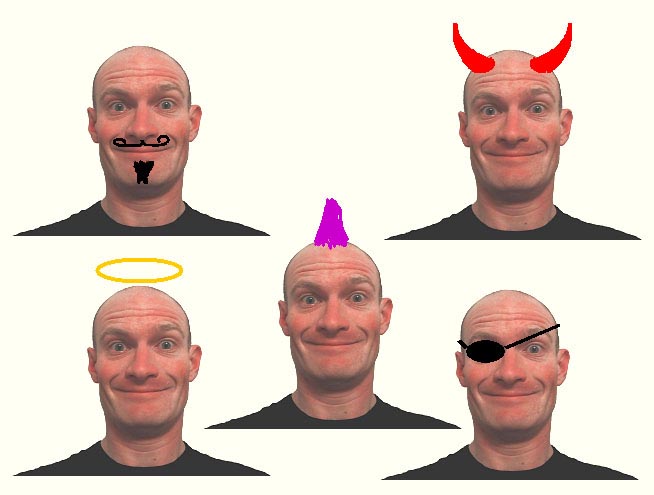

0 Comments:
Post a Comment
<< Home